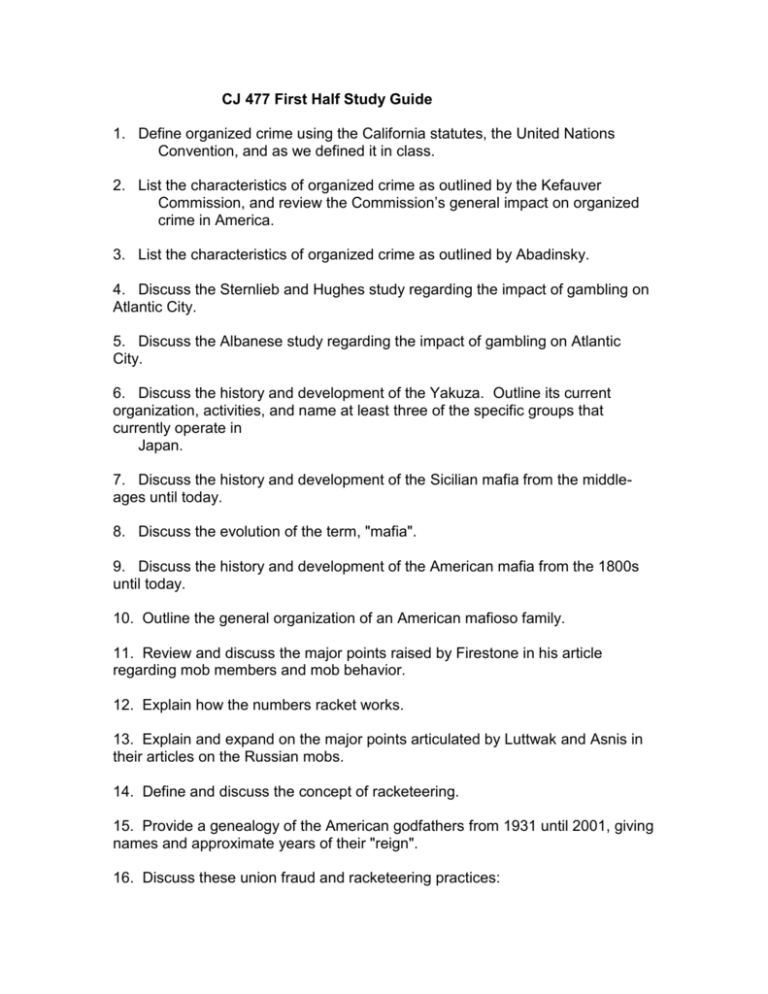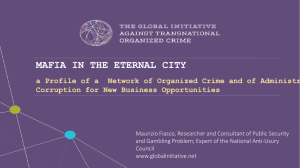CJ 477 Study Guide
advertisement

CJ 477 First Half Study Guide 1. Define organized crime using the California statutes, the United Nations Convention, and as we defined it in class. 2. List the characteristics of organized crime as outlined by the Kefauver Commission, and review the Commission’s general impact on organized crime in America. 3. List the characteristics of organized crime as outlined by Abadinsky. 4. Discuss the Sternlieb and Hughes study regarding the impact of gambling on Atlantic City. 5. Discuss the Albanese study regarding the impact of gambling on Atlantic City. 6. Discuss the history and development of the Yakuza. Outline its current organization, activities, and name at least three of the specific groups that currently operate in Japan. 7. Discuss the history and development of the Sicilian mafia from the middleages until today. 8. Discuss the evolution of the term, "mafia". 9. Discuss the history and development of the American mafia from the 1800s until today. 10. Outline the general organization of an American mafioso family. 11. Review and discuss the major points raised by Firestone in his article regarding mob members and mob behavior. 12. Explain how the numbers racket works. 13. Explain and expand on the major points articulated by Luttwak and Asnis in their articles on the Russian mobs. 14. Define and discuss the concept of racketeering. 15. Provide a genealogy of the American godfathers from 1931 until 2001, giving names and approximate years of their "reign". 16. Discuss these union fraud and racketeering practices: double deposit/loan/kickback scam hiring hall scams paper locals (all three kinds) pension loan fund scams strike insurance sweetheart contracts 17. Review the story line, as discussed in class, of what lead up to Hoffa’s death and the details of that “execution.” Include the roles of Bufalino, Fitzsimmons, the Nixon administration, Sheeran, and Provenzano in your response. 18. Discuss the history of prostitution law in the western world from roughly 1800 until today. 19. Discuss the rulings of these court cases: Ratzlaf v U.S. Reves v. Ernst and Young U.S. v. 92 Buena Vista Avenue U.S. v. James Daniels U.S. v. Sullivan 20. Discuss the Tax Relief and Health Care Act of 2006 in the context of its whistleblowing provision, and the concept of Qui Tam suits as articulated in the False Claims Act of 1863. 21. Discuss RICO in the context of its role as an organized crime fighting instrument. Review the court cases surrounding its application, what has to be shown for a case to be successfully brought under a RICO prosecution/civil action, and the potential impact upon those who are convicted and/or face a civil judgment under the RICO statutes. 22. Discuss the difference between the concepts of In Personam forfeiture and In Rem forfeiture. 23. Discuss the concept of money laundering and review the provisions of several American laws that address this matter, as well as several related international conventions. Include some reference to CTRs, smurfing, Ratzlaf v. U.S., and FinCen. 24. Detail each step of the money laundering process, with some focused discussion of Step 2 options as reviewed in class (boilerplate model, mobile asset/chop model, Hawala system, electronic transfer, false invoices, land flipping, hot plastic). 25. Review and discuss the eight strategies that the United Nations recommends countries undertake to combat money laundering, and explore the whistleblowing and Qui Tam laws that are in place in the United States in this context. 26. What are the characteristics of businesses that have a low risk of being infiltrated by organized crime. 27. Discuss the difficulties of prosecuting Asian organized crime groups. 28. Discuss the history and development of the Triads. Outline its current organization, activities, and name some of the groups that currently operate in Southeast Asia. 29. Review the predictions of Hyatt and Tafoya regarding the state of organized crime in the 21st century. 30. Discuss the history and development of the Colombian drug cartels (with a focus on the life and times of Pablo Escobar). 31. Discuss the history and development of the major Mexican drug cartels, and review their current activities as well as the current situation “on the streets.” 32. List and discuss the history and activities of the four major motorcycle gangs in America. 33. Discuss the Protect Act and its provisions, and specifically explore in some detail the legal conflicts it accentuates. 34. Provide a detailed description of the following in the context of our class discussion: Albert Anastasia Apalachin, New York/Joseph Barbara Aryan Brotherhood Bank of Credit and Commerce International (BCCI) Barker-Karpis Gang Bicheiros Black Sox Scandal (Charles "Chick" Gandil/"Sports" Sullivan) Bonnie and Clyde Boston Brinks Robbery of 1950 Lepke Buchalter Tommaso Buscetta Roberto Calvi Camorra/Ndrangheta Alphonse Capone Judith Exner Campbell Frank Costello Thomas Dewey "Legs" Diamond (John T. Nolan) John Dillinger Pablo Escobar/Medellin Cartel FARC/ELN Jimmy Frantiano Carlo Gambino Vito Genovese Sam Giancana Vinny "The Chin" Gigante Gizya/Jizya John Gotti Salvatore "Sammy the Bull" Gravano Michael Greco Hawala David Hennessey Jimmy Hoffa/Robert Kennedy Jamaican Posse Jessie James "Machine Gun" Kelly (George Kelly Barnes; how did this case impact the development of federal law enforcement) Richard "The Ice Man" Kuklinski La EME, La Nuestra Familia, Texas Syndicate Meyer Lansky Sonny Liston Lucky Luciano Marcello/Giancana/Johnson connection re JFK assassination McClellan Committee Money Laundering (CTRs, smurfing, American laws, international conventions, FinCen) Night of the Sicilian Vespers/Castellammarese War Nishinstvo Nugan-Hand Bank Omerta/Vorovskoy Zakon The Outfit Pizza Connection Episode/Gaetano Badalamenti Sidney Reilly Toto Riina/Corleonesi family Arnold Rothstein Russian mobs (Semion Mogilevich, Viktor Bout) St. Valentine's Day Massacre Hasan Ben Sabbah "Dutch" Schultz (Arthur Flegenheimer) Benjamin "Bugsy" Siegel Sokaiya Mont Tennes Tongs Triads Johnny Torrio Joseph Valachi Yakuza Yamaguchi Gumi ******************************************************************************************** **************************************** CJ 477 Second Half Study Guide (remember that the final is comprehensive) 1. Explain the Ermann and Lundman corporate deviance typology and give actual detailed examples/case studies for each of the categories. 2. Discuss the following in the context of corporate and/or government crime: Bhopal, India/Union Carbide Disaster Ivan Boesky CIA Covert Operations - Italy, Guatemala (Arbenz/Armas), Iran (Mosaddegh/Shah), Cuba (Bay of Pigs), Vietnam (Operation Phoenix), October Surprise, Iran/Contra Defense Industry Frauds - Revolving Door Concept; Open End vs. Closed End Contracts Doolittle Report Dresden Incineration Bombing Adolph Eichmann Electric Industry Price Fixing Enron Equity Funding Corporation Ford/Pinto Affair General Motors/Corvair Affair Interpol Love Canal Episode Medicare/Medicaid Fraud (different types) Michael Milken J. P. Morgan Pharmaceutical/Chemical Dumping (different types) Planned Bankruptcy Charles Ponzi and the general Ponzi Scheme Rape of Nanking Pol Pot John D. Rockefeller Rocky Flats, Colorado Oskar Schindler/Chiune Sugihara/Raoul Wallenberg/Irena Sendler Teapot Dome Scandal Times Mirror-Chandler Trust Tax Evasion Scam Tuskegee Experiments 3. Discuss the Watergate episode and be able to identify the following persons/organizations (see the class handout as well): Archibald Cox CREEP John Dean Deep Throat Sen. Sam Ervin Leon Jaworski John Mitchell Plumbers Judge John Sirica Woodward and Bernstein 4. Discuss the development of the opium/heroin trade from an historical perspective. 5. Discuss the history of the criminalization of marijuana in the United States (Anslinger, DuPont, Mellon). 6. Discuss the concept of government corruption. Discuss the two forces that seem to be increasing our awareness and response to corruption. What are some of the methods used to measure corruption and how extensive is it (refer particularly to the Transparency International research)? Review some of the international conventions against corruption. 7. Discuss the Iran/Contra episode and be able to identify the following: Ricardo Bilonick Boland Amendments George Bush, Sr. California Cocaine Connections (Blandon, Ross, Meneses) William Casey Eugene Hasenfus Albert Hakim Robert McFarlane Manuel Noriega Oliver North Operation Nifty Package John Poindexter Sandinista Somozas/Contra rebels 8. Discuss Operation Nifty Package and the dynamics of the subsequent trial of Manual Noriega. 9. Discuss the concept of International Law, including definitions of war crimes, crimes against peace, genocide, and crimes against humanity. 10. Review the development of the international courts that now exist, and provide some details regarding the current aspects and operations of these tribunals. 11. Discuss the history and development of the Holocaust, including the principles outlined by Hitler in Mein Kampf, and a detailed review of the seven graduated solutions to the “Jewish problem” as they evolved over time. 12. Review the historical episode known as Operation Hummingbird or Night of the Long Knives, and the events that unfolded thereafter. 13. Review the historical development of the Nuremberg Trials, discuss the legal arguments that were raised during the trial, and the extra-legal aspects of that tribunal. 14. Identify and discuss in some detail, the five legal arguments that were raised in the trial of Adolph Eichmann. What was the 6th legal argument, and why was it not raised in open court? 15. Discuss in some detail: Armenian genocide. Cambodian genocide Rwandan genocide The Holodomor The Rape of Nanjing 16. Discuss the life and times of Ferdinand Marcos from an organized crime context. 17. Discuss a number of problems in prosecuting organized crime. 18. Discuss a number of problems in prosecuting corporate crime. 19. List and discuss ten organized crime fighting tactics. Be able to respond to some of the difficulties, and the pros and cons for using these tactics. 20. Discuss aspects and elements of the different types of immunity we reviewed in class (transactional, use, historical, prospective), and review the ethical and pragmatic problems of using immunity as a law enforcement instrument in some detail. 21. Discuss the use of informants as a law enforcement tool. Differentiate between the use of immunity and the use of informants as a law enforcement tool? Review the ethical and pragmatic problems of using informants, and discuss the difference between historical and prospective immunity. 22. Identify the rules of law handed down in the following cases: Indiana v. Ford Motor Corp Santa Clara County v. Southern Pacific Railroad U.S. v. Park 23. List a number of long term responses to organized crime we should be making as a society as proposed by Alexander and Caiden. List a number of short term responses to organized crime as proposed by the same authors. Discuss problems with their ideas. 24. What are some of the proposals set forth by Ermann and Lundman regarding ways of controlling business corruption. 25. Discuss the major points raised by Moore in his article regarding the future of organized crime. 26. Review Richard Ofshe's study of Synanon. How are organizations able to get its members to commit acts of violence. Discuss the ways Synanon kept people from leaving the organization.










